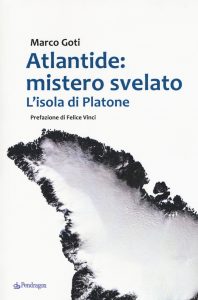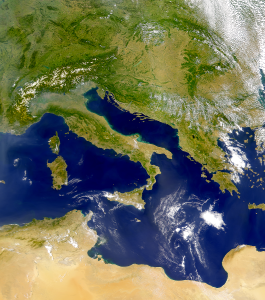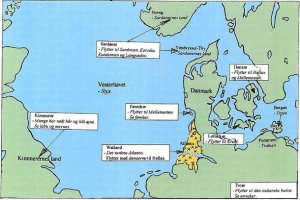Felice Vinci
Biglino, Mauro
Mauro Biglino is the Italian author of many controversial books about our ancient past. Like Felice Vinci, he maintains that the  Baltic region has played a more important part in our prehistory than is generally accepted. While Vinci has focused on the Baltic as the source of Homeric epic tales, Biglino has sought to link many biblical episodes with the Baltic. Two books [1907][1908] in particular, co-authored with Cinzia Mele, highlight their theories, but unfortunately, both are, so far, available in Italian only. However, papers associated with these books translate well with the MS Edge translator(a).
Baltic region has played a more important part in our prehistory than is generally accepted. While Vinci has focused on the Baltic as the source of Homeric epic tales, Biglino has sought to link many biblical episodes with the Baltic. Two books [1907][1908] in particular, co-authored with Cinzia Mele, highlight their theories, but unfortunately, both are, so far, available in Italian only. However, papers associated with these books translate well with the MS Edge translator(a).
My interest in Biglino’s work was to the extent that it dovetailed with the theories of Felice Vinci, beyond that, please note that Biglino is an ancient astronaut fan in the mould of Erich von Däniken
and Zechariah Sitchin.
Atlantisforschung in a review(b) of Biglino’s work noted the following rhetorical questions put forward by the author (1) Was the god Yahweh just one of many gods who landed on our planet thousands of years ago and then exercised dominion over the earth? (2) Was he so opposed to the worship of other gods because of a dispute over supremacy that sometimes escalated into great wars? (3) And are we ourselves possibly the result of gene experiments that took place on earth back then because the gods needed a race of servants? This should give you an idea of Biglino’s line of thought.
>In 2023, Biglino published Gods of the Bible, in English, in which he expanded on his interpretation of the Bible as evidence of ancient extraterrestrial visitors. He has also written an article for Graham Hancock’s website, as ‘Author of the Month’, giving some of the background to the book(c).<
(b) Mauro Biglino – Atlantisforschung.de (atlantisforschung-de.translate.goog)
Harris, Stuart L.
Stuart L. Harris is an American researcher, self-described as an linguist, historian and archaeologist.  He has contributed over eighty papers to the Migration & Diffusion website(a) and dozens to the Academia.edu site(b). He has touched on a wide variety of subjects; from Comet Encke to Glozel and Newgrange to Noah’s Flood. Although I am not a linguist, I think that that Harris’ penchant for ‘finding’ evidence of the Finnish language in locations as far apart as Dacia, Gaul, Teotihuacan and Hawaii is highly questionable, but I shall leave it to others, more skilled than I, to comment further.
He has contributed over eighty papers to the Migration & Diffusion website(a) and dozens to the Academia.edu site(b). He has touched on a wide variety of subjects; from Comet Encke to Glozel and Newgrange to Noah’s Flood. Although I am not a linguist, I think that that Harris’ penchant for ‘finding’ evidence of the Finnish language in locations as far apart as Dacia, Gaul, Teotihuacan and Hawaii is highly questionable, but I shall leave it to others, more skilled than I, to comment further.
Inspired by Felice Vinci, Harris has promoted the idea of Troy in Finland, but until lately he had not directly addressed the question of Atlantis, but in recent private correspondence with me, he has claimed that Plato’s lost island had been situated in the vicinity of Rockall and destroyed around 9577 BC. He later published these ideas in a number of papers on the Academia.edu website(c-f) in which he proposed that a close encounter with Nibiru (Marduk) that resulted in a number of its satellites impacting the Earth, causing devastation which included the demise of Atlantis. He also equated Nibiru with Marduk. The article contains a lot of wild speculations including the suggestion that Nibiru on a return to Earth in 9417 BC, lost another of its satellites, which became our Moon!
(a) https://www.migration-diffusion.info/article.php?authorid=113
(b) https://independent.academia.edu/StuartHarris3
Goti, Marco
Marco Goti is the Italian author of The Island of Plato[1430] in which he attempts to demonstrate  that Atlantis was situated in Greenland. I say attempts because, in my opinion, he fails dismally. He starts by locating the Pillars of Heracles in the Atlantic, with one side being the basaltic columns at the Giants Causeway in Northern Ireland and their counterparts across the sea in Scotland’s Isle of Staffa. This idea was touted by W. C. Beaumont over sixty years earlier(a).
that Atlantis was situated in Greenland. I say attempts because, in my opinion, he fails dismally. He starts by locating the Pillars of Heracles in the Atlantic, with one side being the basaltic columns at the Giants Causeway in Northern Ireland and their counterparts across the sea in Scotland’s Isle of Staffa. This idea was touted by W. C. Beaumont over sixty years earlier(a).
The Cyclopean Islands off the east coast of Sicily near Mt. Etna referred to by Homer in his Odyssey are also known for their basaltic columns.>>At Gunung Padang and Nan Madol there are also numerous columns with comparable volcanic origins.<<
Goti then moves on to Iceland, which he identifies as Thule and spends too much time describing a variety of unpronounceable locations there. He eventually heads for Greenland, which he contends must be Atlantis as it is greater than Libya and Asia combined, ignoring that Plato was referring to might rather than size. Goti posits the huge plain described by Plato to have been situated in the centre of Greenland, ignoring the fact that ice cores dated to over 100,000 years have been identified there, and apart from which the huge island is not submerged. He offers two papers with extracts from his book(b)(c) as well as some evidence of neolithic activity in Greenland(d).
Felice Vinci, who clearly offered some inspiration to Goti, wrote the Foreword to the book and also provided Goti with an archaic Athens in Sweden!
Goti decries other promoters of Atlantis theories for ignoring details in Plato’s account that don’t fit their particular ideas and then he moves Athens to Sweden, has Atlantis above water for hundreds of thousands of years, no elephants, no two annual crops and does not explain how Greenland Atlanteans controlled southern Italy as far as Tyrrhenia, all of which demands a thumbs down from me.
(a) https://www.theflatearthsociety.org/library/pamphlets/Is%20Britain%20the%20Lost%20Atlantis.pdf
(b) The Geometry of Atlantis according to Plato (1/2) – The Tapestry of Time (larazzodeltempo.it)
(c) The Geometry of Atlantis according to Plato (2/2) – The Tapestry of Time (larazzodeltempo.it)
Origin of the Atlantis Narrative *
The Origin of the Atlantis Narrative is declared by Plato to have been Egyptian as it was brought to Athens from Egypt by Solon. This is the almost universally accepted provenance of the story. However, other suggestions have emerged from time to time.
Felice Vinci, who is probably best known for his Homer in the Baltic believes that the origins of most of Greek mythology are to be found in northern Europe.
Another even more exotic claim(a) is that Plato’s Atlantis story was a reworking of the destruction of Lankapura as recorded in the Ramayana(b), one of the two great Hindu epic poems.
Dhani Irwanto claims that its origins lie in Indonesia and were later carried by refugees to Egypt, presumably via the Indus Valley and Sumeria!
Ashok Malhotra believes that the Atlantis tale originated in the Indus Valley(c), inspired by the submergence of Dwarka, and then moved westward via Sumeria.
(a) https://archives.sundayobserver.lk/2001/pix/PrintPage.asp?REF=/2013/03/17/mon06.asp (Offline Sept.2017 – See Archive 2058)
(b) http://www.valmikiramayan.net/ (link broken)
Italy
Italy seems to have an uncertain etymology; Thucydides claims that Italos, the Sicilian king gave his name to Italy, while more recently Emilio Spedicato(h) considers that ”the best derivation we believe to be the one proposed by the Italian nuclear engineer Felice Vinci (1998), in his monograph claiming a Baltic setting for the Homeric epic: he derives Italia from the rare Greek word aithalia, meaning the smoking one.” This is thought to be a reference to Italy’s many volcanoes.
Italy today is comprised of territory south of the Alps on mainland Europe including a very large boot-shaped peninsula, plus Sicily, Sardinia and some smaller island groups, which along with the French island of Corsica virtually enclose the Tyrrhenian Sea.
The earliest proposal that Italy could be linked with Atlantis came from Angelo Mazzoldi in 1840 when he claimed that before Etruria, Italy had been home to Atlantis and dated its demise to 1986 BC. Mazzoldi expressed a form of hyperdiffusion that had his Italian Atlantis as the mother culture which seeded the great civilisations of the eastern Mediterranean region(b).
Some of Mazzoldi’s views regarding ancient Italy were expanded on by later scholars such as Camillo Ravioli, Ciro Nispi-Landi, Evelino Leonardi, Costantine Cattoi, Guido DiNardo and Giuseppe Brex. Ravioli sought to associate the Maltese island of Gozo with his proposed Atlantis in Italy.
The Italian region of Lazio, which includes Rome, has had a number of very ancient structures proposed as Atlantean; Monte Circeo (Leonardi) and Arpino(a) (Cassaro). Another aspect of Italian prehistory is the story of Tirrenide, which was described as a westward extension of the Italian landmass into the Tyrrhenian Sea during the last Ice Age, with a land bridge to a conjoined Sardinia and Corsica. At the same time, there were land links to Sicily and Malta, which were all destroyed as deglaciation took place and sea levels rose.
 It is surprising that so few researchers have commented on Italy’s part in Plato’s Atlantis narrative considering that he twice, without any ambiguity, informs us that the Atlantean domain extended as far as Tyrrhenia (modern Tuscany).
It is surprising that so few researchers have commented on Italy’s part in Plato’s Atlantis narrative considering that he twice, without any ambiguity, informs us that the Atlantean domain extended as far as Tyrrhenia (modern Tuscany).
Crit.114c. So all these, themselves and their descendants dwelt for many generations bearing rule over many other islands throughout the sea and holding sway besides, as was previously stated, over the Mediterranean peoples as far as Egypt and Tuscany. Tim.25a/b. Now in this island of Atlantis there existed a confederation of kings, of great and marvellous power, which held sway over all the island, and over many other islands also and parts of the continent; and, moreover, of the lands here within the Straits they ruled over Libya as far as Egypt, and over Europe as far as Tuscany. (Bury)
The quotation from Timaeus is most interesting because of its reference to a ‘continent’. Some have understandably but incorrectly claimed that this is a reference to America or Antarctica, when quite clearly it refers to southern Italy as part of the continent of Europe. Moreover, Herodotus is quite clear (4.42) that the ancient Greeks knew of only three continents, Europe, Asia and Libya.
Philo of Alexandria (20 BC-50 AD) in his On the Eternity of the World(g) wrote “Are you ignorant of the celebrated account which is given of that most sacred Sicilian strait, which in old times joined Sicily to the continent of Italy?” (v.139).>The name ‘Italy’ was normally used until the third century BC to describe just the southern part of the peninsula(e).<Some commentators think that Philo was quoting Theophrastus, Aristotle’s successor. This would push the custom of referring to Italy as a ‘continent’ back near to the time of Plato. More recently, Armin Wolf, the German historian, when writing about Scheria relates(f) that “Even today, when people from Sicily go to Calabria (southern Italy) they say they are going to the ‘continente’.” This continuing usage is further confirmed by a current travel site(d) and by author, Robert Fox[1168.141]. I suggest that Plato used the term in a similar fashion and can be seen as offering the most rational explanation for the use of the word ‘continent’ in Timaeus 25a.
When you consider that close to Italy are located the large islands of Sicily, Sardinia and Corsica, as well as smaller archipelagos such as the Egadi, Lipari and Maltese groups, the idea of Atlantis in the Central Mediterranean can be seen as highly compatible with Plato’s description.
If we accept that Plato stated unambiguously that the domain of Atlantis included at least part of southern Italy and also declared that Atlantis attacked from beyond the Pillars of Heracles, then this appellation could not be applied at that time to any location in the vicinity of the Strait of Gibraltar but must have been further east, probably not too far from Atlantean Italy. This matches earlier alternative locations recorded by classical writers who placed the ‘Pillars’ at the straits of Messina or Sicily. I personally favour Messina, unless there is stronger evidence that some of the islands in or near the Strait of Sicily such as the Maltese or Pelagian Islands or Pantelleria were home to the ‘Pillars’.
(a) http://www.richardcassaro.com/hidden-italy-the-forbidden-cyclopean-ruins-of-giants-from-atlantis
(b) Archive 2509P (Eng) Archive 2943 (Ital)
(c) Archive 2946
(d) Four Ways to Do Sicily – Articles – Departures (archive.org)
(e) https://profilbaru.com/article/Name_of_Italy *
(f) Wayback Machine (archive.org)
(g) http://www.earlychristianwritings.com/yonge/book35.html
(h) http://2010-q-conference.com/ophir/ophir-27-10-09.pdf
Joramo, Morten Alexander
 Morten Alexander Joramo is a Norwegian astrologer, musician and author. In his 2011 book, The Homer Code[1075], he is heavily influenced by Felice Vinci, who situated Homer’s Odyssey in the northern European region. Joramo specifically identifies the island of Trenyken, in Norway’s Outer Lofoten Islands, with Homer‘s legendary Thrinacia. He also refers to the work of Iman Wilkens and Jürgen Spanuth. He also introduces the Bock Saga in support of his contention that “that there must have been an advanced culture in the high north thousands of years ago.”(a)
Morten Alexander Joramo is a Norwegian astrologer, musician and author. In his 2011 book, The Homer Code[1075], he is heavily influenced by Felice Vinci, who situated Homer’s Odyssey in the northern European region. Joramo specifically identifies the island of Trenyken, in Norway’s Outer Lofoten Islands, with Homer‘s legendary Thrinacia. He also refers to the work of Iman Wilkens and Jürgen Spanuth. He also introduces the Bock Saga in support of his contention that “that there must have been an advanced culture in the high north thousands of years ago.”(a)
Although the author touches on the subject of Atlantis in The Homer Code he expands more fully on it the following year in Atlantis Unveiled[1076]. In it he again follows much of Vinci’s work as well as Spanuth’s identification of Helgoland as the location of Atlantis. He also uses Homer as well as copious extracts from Apollonius of Rhodes to justify his identification of Northern Europe as the backdrop to both the Odyssey and Plato’s Atlantis narrative.
Up to this point I found his work interesting, if not convincing. However, when I got to his ancient alien conspiracy theory and the use magic mushrooms, I cried halt.
In 2015, Joramo published The Lost Civilization of the North[1170], which is intended to supplant Atlantis Unveiled.
(a) https://www.goodreads.com/book/show/11337705-the-homer-code
(b) https://www.goodreads.com/book/show/22156233-atlantis-unveiled
Faroe Islands
 The Faroe Islands are a small archipelago in the North Atlantic between Norway and Iceland. It has been proposed that they contained the island of Ogygia, the home of Atlas’ daughter Calypso. Plutarch recorded that Ogygia was five days sailing from Britain and has been incorporated into the theories of a number of writers supporting a North Sea Atlantis, such as Felice Vinci and later John Esse Larsen.
The Faroe Islands are a small archipelago in the North Atlantic between Norway and Iceland. It has been proposed that they contained the island of Ogygia, the home of Atlas’ daughter Calypso. Plutarch recorded that Ogygia was five days sailing from Britain and has been incorporated into the theories of a number of writers supporting a North Sea Atlantis, such as Felice Vinci and later John Esse Larsen.
*Larsen contends that Odysseus means ‘Isse from the island Od’, a former Danish island, which is now a peninsula. In fact he interprets Homer’s Odyssey as a description of a trip around the Baltic Sea(c). Furthermore the Pillars of Herakles have also been identified by Larsen with the village of Eide on the Faroes(a).*
In November 2018, I was directed to a German website(b) which also refers to the Faroe Islands as having an Atlantean connection, but in this case, Jan, its author, proposes that Atlantis was located between Spitsbergen and Franz Josef Land explaining that “It looks like our Earth is Atlantis, and in the northern part of the Earth was hyperborea, Greenland might have been Mu, and Antarctica was Lemuria. It was a pole shift that caused Atlantis to go down. At that time Spitzbergen was probably at the height of the Canary Islands and the Antarctic must have been located at the height of today’s Philippines.”
(a) https://odisse.me.uk/odysseus-isse-from-the-island-od-in-denmark-2.html
*(b) https://ich-fand-atlantis.org/atlantis/ (link broken Sept. 2019)
(c) https://odisse.me.uk/odysseus-tour-round-the-baltic-sea.html*
Larsen, John Esse
John Esse Larsen is an independent Danish researcher who has expressed similar  views to Felice Vinci regarding the Baltic origins of Homer’s epic tales, Iliad and Odyssey, in his 2012 book, Odysseus: Isse fra Od[1048]. He identifies many of the p
views to Felice Vinci regarding the Baltic origins of Homer’s epic tales, Iliad and Odyssey, in his 2012 book, Odysseus: Isse fra Od[1048]. He identifies many of the p lacenames recorded by Homer with Baltic and North Sea locations.
lacenames recorded by Homer with Baltic and North Sea locations.
>In addition, he identified the town of Bergen, on Germany’s largest island of Rügen, as Troy(c).
Larsen has also generously given Ireland a place in the Odyssey naming the Co. Donegal hillfort Grianan an Aileach as the home of Circe! Pure speculation.<
>Larsen has an English language website(a) where many of his ideas are outlined, including an identification of the Pillars of Heracles with two huge sea stacks off the Faroe Islands and Atlantis with Watland in the Wadden Sea region of the North Sea(b), Kirsten Bang had suggested the same location for Atlantis a few years earlier[679].<
(a) https://odisse.me.uk/index.html
(b) https://odisse.me.uk/watland-in-the-north-sea-atlantis.html
(c) http://odisse.me.uk/troy-the-town-bergen-on-the-island-rugen-2.html *
Behrends, Arno (L)
Arno Behrends is the author of Nordsee-Atlantis[942] which offers an example of the most recent support for the theories of Jürgen Spanuth. In addition to the arguments of Spanuth’s he adds the modern commentators on Homer’s Odyssey, such as Felice Vinci, who have advanced the idea that Homer’s story originated in northern Europe, which enhances the possibility that Plato’s narrative came from the same source!
Langdon, Robert John *
Robert John Langdon is the Brighton based British author of Prehistoric Britain: The Stonehenge Enigma[919], the first part of a trilogy(b). The book was first published in  2010 with a second edition brought out in 2013. The final chapter of the second edition is now available online(a). In it, he contends that the megalith builders came from Africa to Doggerland at the end of the last Ice Age, however, as the waters rose submerging Doggerland, the megalith builders had to move to higher ground on what we now know as Great Britain, eventually constructing Stonehenge as a memorial! Furthermore, he claims that Doggerland was Atlantis(g).
2010 with a second edition brought out in 2013. The final chapter of the second edition is now available online(a). In it, he contends that the megalith builders came from Africa to Doggerland at the end of the last Ice Age, however, as the waters rose submerging Doggerland, the megalith builders had to move to higher ground on what we now know as Great Britain, eventually constructing Stonehenge as a memorial! Furthermore, he claims that Doggerland was Atlantis(g).
Langdon claims that the Altar Stone at Stonehenge points to Doggerland, which he identifies as the location of Atlantis. He also claims that the Slaughter Stone is in fact a representation of the flooded world of those megalith builders. Langdon is highly critical of the generally accepted interpretation of various features found at Stonehenge, listing 13 items that he claims “don’t make sense”(f).
Another of Langdon’s claims is that “Cro-Magnon/Atlanteans colonised America” based on a study of blood group distribution(e).
Additionally, Langdon has now entered the debate regarding the location of Troy, moving it to the North Atlantic and citing the work of both Iman Wilkens and Felice Vinci(h).
In September 2014, Langdon changed his website(c) and published further excerpts from his books.
His second volume was published in 2016[1242]. There are also a number of related free pdf books available on his website.
In 2022, he self-published 13 Ancient Things That Don’t Make Sense in History [2069], with some excerpts offered online(b)(h). Langdon has also published a book on the ‘lost stone avenue’ at Avebury, which is now available on the Academia website(i).
(a) The Post Glacial Flooding Hypothesis (archive.org)
(b) http://www.prehistoric-britain.co.uk/
(c) http://www.the-stonehenge-enigma.info/
(e) The Post Glacial Flooding Hypothesis: Cro-Magnon/Atlanteans colonised America (archive.org)
(f) The Post Glacial Flooding Hypothesis: The Great Stonehenge Hoax (archive.org)
(g) Chapter 3 – Atlantis – Dawn of the Lost Civilisation (archive.org) *
(i) https://www.academia.edu/11335093/Aveburys_Lost_Stone_Avenue
